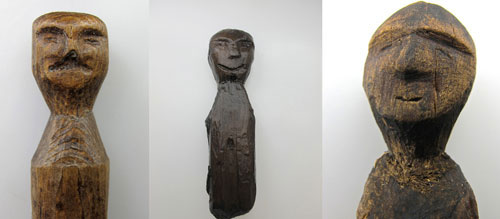The mysterious extinction in the Arctic
The recent genetic research has traced the "hobbit" in the Arctic, in an attempt to find the answer to the complete disappearance of this breed.
About 700 years ago, the ancient Eskimo finally disappeared from the North Pole, ceding the icy land to the ancestors of the Inuit and Eskimo cultures today. What happened to the community (called Dorset culture) has always been a mystery. However, now an in-depth study has shown that this group may have been pushed into the path of extinction because of its close relationship with climate change, causing them to gradually disappear in loneliness. when other groups continue to exist. From the analysis of ancient DNA, scientists have suddenly discovered that the first people to the Arctic no longer retain any descendants to this day.

Remnants of Dorset culture - (Photo: Aberdeen University)
The original owner of the Arctic may have reached this place through Bering's waist about 6,000 years ago. This is also the area where people eventually settled due to harsh natural conditions and cold year-round. From a previous study, the scientific community divided the Arctic communities into two groups: the ancient Eskimo and the modern Eskimo (it took nearly 4,000 years to reach the land). This means that the ancient Eksimo lived in isolation from the outside world for more than 4 millennia. However, the modern Eskimo Arctic landing from Siberia around 1,500 has pushed the original Eskimo into a state of threat, and for several decades, the ancient "hobbit" period of the ancient arrived.
According to the Science report, a group of more than 50 experts from scientific institutions around the globe, led by the Danish National Museum's Dr. Maanasa Raghavan, analyzed DNA from bone and tooth samples, Hair of 169 ancient human remains comes from Siberia, Alaska, Canada, Greenland. For comparison, they also decoded the entire genetic sequence of seven modern humans, including an Inuit in Greenland, two Nivkhs in Siberia, two in the Aleutian Islands, and two Athabasca Aboriginal Americans. The results show that the Dorset culture ended in the period 1150 to 1350, quickly replaced by Eskimos who hunted whales, called Thule culture . Newcomers bring advanced technology from Asia, including complex weapons such as power boosts, and more efficient means of transport, such as dog trailers.
It has been suggested that Thule's rise was 'an example of prehistoric genocide , ' according to NBC News, which co-authored the study, William Fitzhugh, the anthropologist of the Smithsonian Institution. In the new report, the experts found no evidence of sexual exchanges between the two cultures in the Arctic. Another possibility is that diseases brought by Vikings or Thule may have triggered the collapse of the Dorset people. It is estimated that the population of Dorset is probably no more than 3,000 in the Canadian Arctic and another 1,000 in Greenland. Therefore, experts are inclined to hypothesize that inbreeding, disease and climate change have made Dorset people disappear completely in the Arctic.
- The Arctic Sea is the hottest 2,000 years
- Glaciers 'cry'
- Interesting facts about animals living in the Arctic
- Casserole seed pit under the Arctic ice
- Ice in the Arctic Ocean
- Arctic sea ice area is at a record low
- Every second 14,000 tons of water flows into the sea because the Arctic ice melts
- The volume of ice in the Arctic drops to a record low
- Top 10 'kings' speed in the bird world
- Arctic wildlife calls for help
- The Arctic lost three times as much ice as Belgium every day
- The extraordinary journey of the Arctic fox
 Discovered an ancient centipede fossil 99 million years old
Discovered an ancient centipede fossil 99 million years old Discovered bat-like dinosaurs in China
Discovered bat-like dinosaurs in China Discovered a 200-year-old bronze cannon of the coast
Discovered a 200-year-old bronze cannon of the coast Discover 305 million-year-old spider fossils
Discover 305 million-year-old spider fossils After 389 days in the Arctic, costing more than $160 million, hundreds of scientists brought back bad news: What was it?
After 389 days in the Arctic, costing more than $160 million, hundreds of scientists brought back bad news: What was it?  Arctic refreezing plan achieves positive results
Arctic refreezing plan achieves positive results  Let's look at the last flower clusters in the world's polar regions
Let's look at the last flower clusters in the world's polar regions  Proposing 2 'utopian' initiatives to 'save' the polar ice sheet, at first glance everyone thought it was a fantasy
Proposing 2 'utopian' initiatives to 'save' the polar ice sheet, at first glance everyone thought it was a fantasy  Huge wormhole discovered at the bottom of the Arctic Ocean
Huge wormhole discovered at the bottom of the Arctic Ocean  Climate change causes more lightning in the Arctic
Climate change causes more lightning in the Arctic 